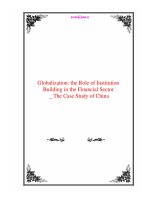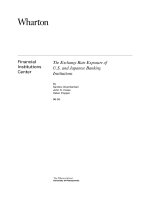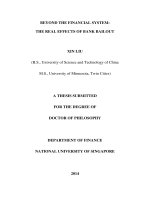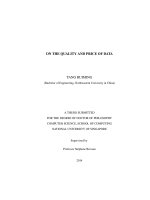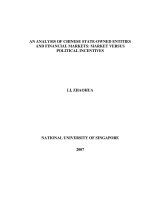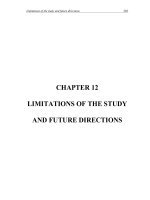the foreign exchange market
Bạn đang xem bản rút gọn của tài liệu. Xem và tải ngay bản đầy đủ của tài liệu tại đây (431.81 KB, 21 trang )
Copyright 2011
Pearson Canada Inc.
19 -
1
Chapter 19
The Foreign Exchange Market
Copyright 2011
Pearson Canada Inc.
19 -
2
Foreign Exchange
•
Exchange rate - price of one currency in terms of
another
•
Foreign exchange market - the financial market where
exchange rates are determined
•
Spot transaction - immediate (two-day) exchange of
bank deposits
–
Spot exchange rate
•
Forward transaction - the exchange of bank deposits
at some specified future date
–
Forward exchange rate
Copyright 2011
Pearson Canada Inc.
19 -
3
Canadian Exchange Rates
Copyright 2011
Pearson Canada Inc.
19 -
4
Foreign Exchange
•
Appreciation—a currency rises in value relative to
another currency
•
Depreciation—a currency falls in value relative to
another currency
•
When a country’s currency appreciates, the country’s
goods abroad become more expensive and foreign
goods in that country become less expensive and vice
versa
Copyright 2011
Pearson Canada Inc.
19 -
5
Exchange Rates in the Long Run
•
Law of one price
•
Theory of Purchasing Power Parity
–
Assumes all goods are identical in
both countries
–
Trade barriers and transportation costs
are low
–
Many goods and services are not traded across
borders
Copyright 2011
Pearson Canada Inc.
19 -
6
Factors that Affect Exchange Rates
in the Long Run
•
if a factor increases the demand for domestic goods
relative to foreign goods , the domestic currency will
appreciate
•
If a factor decreases the relative demand for domestic
goods, the domestic currency will depreciate.
–
Relative price levels
–
Trade barriers
–
Preferences for domestic versus
foreign goods
–
Productivity
Copyright 2011
Pearson Canada Inc.
19 -
7
Purchasing Power Parity Canada/United States
Copyright 2011
Pearson Canada Inc.
19 -
8
Factors Affecting Exchange Rates in the Long Run
Copyright 2011
Pearson Canada Inc.
19 -
9
Exchange Rates in the Short Run
•
An exchange rate is the price of domestic assets in
terms of foreign assets
•
Using the theory of asset demand—the most
important factor affecting the demand for domestic
(dollar) assets and foreign (euro) assets is the
expected return on these assets relative to each other
Copyright 2011
Pearson Canada Inc.
19 -
10
Supply Curve for Domestic Assets
•
Treat Canada as the home country
•
Domestic assets denominated in dollars
•
Generally use euros to represent foreign
country’s currency.
•
Quantity of dollar assets is supplied by bank
deposits, bonds and equities in Cnaada
•
Can take this amount as fixed with respect to
exchange rate
•
vertical supply curve
Copyright 2011
Pearson Canada Inc.
19 -
11
Demand and Supply
for Domestic Assets
•
Demand
–
Relative expected return
–
At lower current values of the dollar (everything
else equal), the quantity demanded of dollar
assets is higher
•
Supply
–
The amount of bank deposits, bonds,
and equities in the U.S.
–
Vertical supply curve
Copyright 2011
Pearson Canada Inc.
19 -
12
Equilibrium in the Foreign Exchange Market
Copyright 2011
Pearson Canada Inc.
19 -
13
Response to an Increase in the
Domestic Interest Rate
Copyright 2011
Pearson Canada Inc.
19 -
14
Response to an Increase in the Foreign Interest Rate
Copyright 2011
Pearson Canada Inc.
19 -
15
Response to an Increase in the
Expected Future Exchange Rate
Copyright 2011
Pearson Canada Inc.
19 -
16
Factors the Shift the Demand Curve for Domestic Assets & Affect the
Exchange Rate I
Copyright 2011
Pearson Canada Inc.
19 -
17
Changes in the Equilibrium Exchange Rate
•
Changes in Interest Rates
–
When the domestic real interest rate rise, the
domestic currency appreciates
–
When domestic interest rates rise due to an
expected increase in inflation, the domestic
currency depreciates.
Copyright 2011
Pearson Canada Inc.
19 -
18
Effect or an Increase in the Domestic Interest
Rate due to an Increase in Expected Inflation
Copyright 2011
Pearson Canada Inc.
19 -
19
Changes in the Money Supply
•
An increase in the level of the money supply leads to a
higher Canadian price level
•
This leads to a lower expected future exchange rate.
•
Decline in expected appreciation of the dollar
decreases the quantity of dollar assets demanded at
each level of the exchange rate.
–
Demand curve shifts left
•
Rise in real money supply causes the domestic
interest rate to fall which lowers the relative expected
return on dollar assets
•
A higher domestic money supply causes the domestic
currency to depreciate
Copyright 2011
Pearson Canada Inc.
19 -
20
Exchange Rate Overshooting
•
Monetary Neutrality
–
In the long run, a one-time percentage rise in the money
supply is matched by the same one-time percentage rise in
the price level
•
The exchange rate falls by more in the short run than
in the long run
–
Helps to explain why exchange rates exhibit so much
volatility
Copyright 2011
Pearson Canada Inc.
19 -
21
Effect of a Rise in the Money Supply
